Plane Iron Getting Soft?
Actually, they mostly remain the same as when they were first made, hardened and tempered at the business end. Moving along from hardened steel at the first inch of the cutting end to the softer metal further away inevitably results in reaching soft and unhardened steel. Moving up the steel an inch or so from the original cutting edge is usually where the steel starts to change and the majority of the steel blade is not hardened. Of course, I am talking about my Stanley and Record versions, these are the most widely distributed by a thousandfold to any modern-day maker, I should surmise.

I doubt that many woodworkers have got through as many plane irons as I have over the past six decades. Why would I say that? Well, all the woodworkers I have ever known through a good half-century, many a thousand, seem always to have worked their wood 95% of the time by machine methods only. No! I tell a lie, 99% of them 99-100% of the time! I’m the rarity and the scarcity — the dinosaur yet to find out that hand tools don’t work too well.
On my #4 Stanley bench plane, I have worn down and honed away five cutting irons and on my #4 1/2, I have gone through four of them to date. I have not recorded the #5s NS 5 1/2s, much to my regret. For me, this fact is pretty phenomenal considering I only grind with a machine once in a blue moon and for several years I never ground them on any kind of grinding machine. Mostly, I’ve found it better and quicker and safer too to do all of my abrading freehand on diamond sharpening plates starting first with the coarser grit. I also use coarse abrasive 150-grit abrasive paper and no machine grinders. I calculate that the total inches of steel I have gone through to be about nine linear inches of 1/8″ thick steel, roughly, or 20 square inches. Economically, that is quite an amazing statistic. Had I used a machine to grind them I would have ground off three or four more times that but grinding does not eliminate honing to optimal levels so not much of a gain speed wise if at all. I can certainly sharpen faster than any machine performance; a working edge takes me from roughly 30 seconds up to a minute.
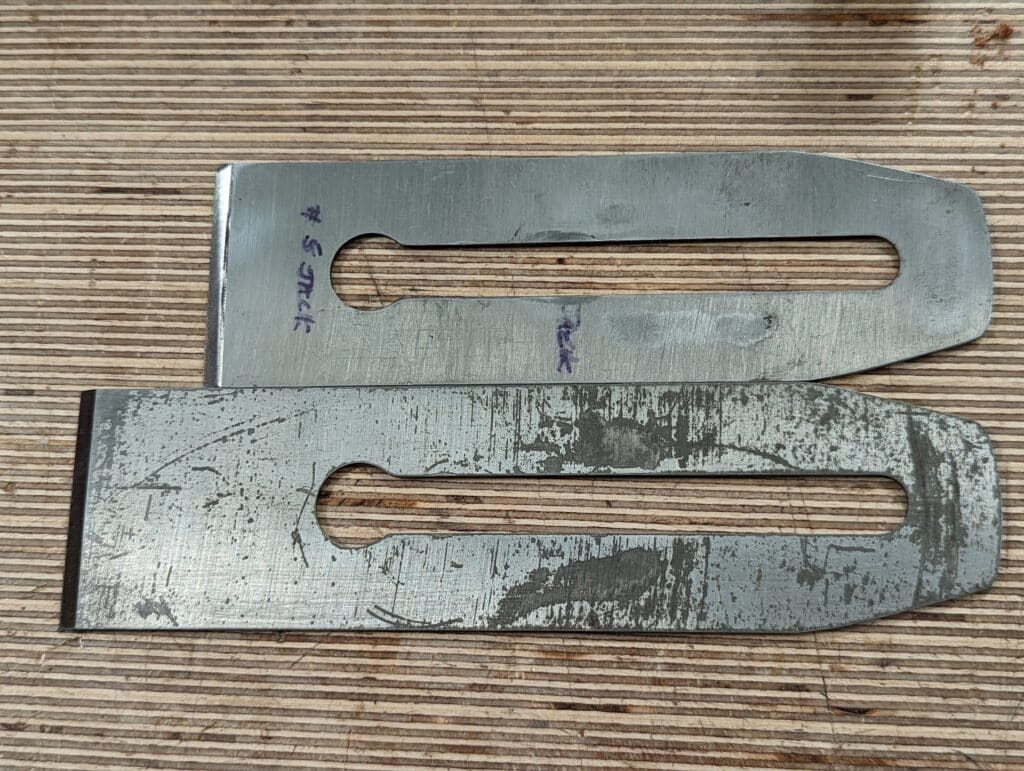
Planing most hardwoods is not too hard on bench planes although some woods can be pretty hard on them; teak is one such wood. Softwoods, pines, spruces and so on, can be very hard on plane cutting edges, harder than woods like maples and such, anyway. The contrast between hard and soft growth rings and then too those spruce knots can be something else. Comparing the mesquite I have been working in the past week or two with woods such as oak, cherry, walnut, sycamore and such, I would say that the sharpness of my cutting iron lasts only about 5% of what I get when working these hardwoods. Though mesquite is almost twice as hard as oak, it is not the hardness that is so much the problem as the silica in the wood. Ten strokes and it’s time to sharpen again.
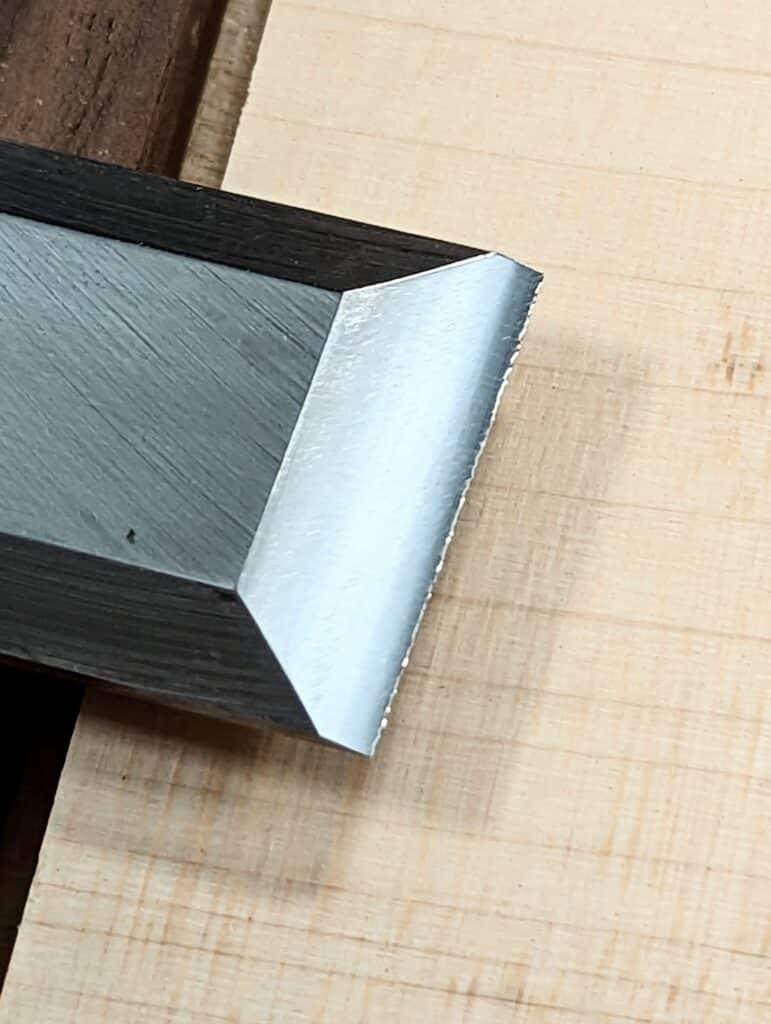
On eBay, I often see the most well-worn cutting irons for sale that you will ever see. Some a mere quarter-inch from the hole. I often wonder if anyone falls for buying them! I have needed to buy two new cutting irons and will likely buy a #4 1/2 soon too. It’s almost reaching a point where it would be cheaper to buy a secondhand #4 plane than an iron alone. The two #4 plane irons cost me £10 apiece but I was looking for older irons and not new ones. As it is with so many things progress, most so-called ‘progress‘ has resulted in inferior quality. At least a pre-sixties iron will be okay. The iron I just received is perfect. Good and hard . . . unfileable!
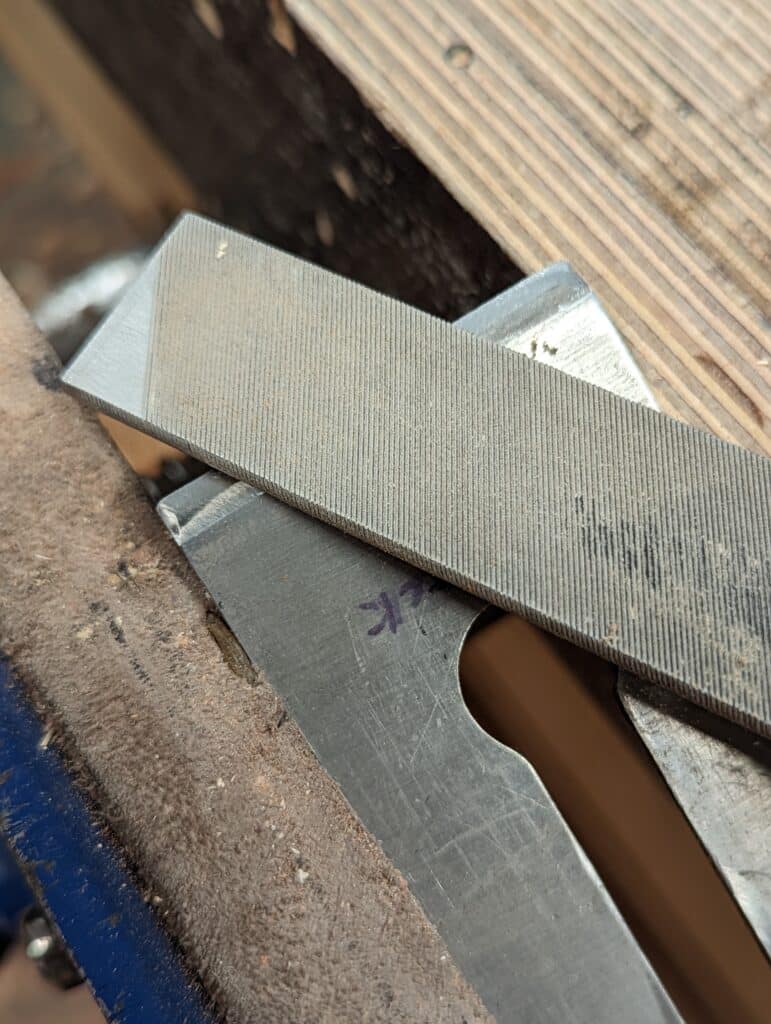
My mesquite really crippled my cutting edge on my #5. It will actually do this on any plane you care to name. Nothing escapes the corrugating ability of mesquite to crumple the fine edges. I tried a Veritas iron and it did the same. I learned this when I made the two White House credenzas for the Cabinet Room of the White House in 2008/9. All planes and saws dull in a few seconds and that is the only downside of choosing mesquite. Planing my sycamore panels took a good hour of use before resharpening was needed. Two long edges of a mesquite door and a couple of other sections 30″ long took me about five minutes and then resharpening was very necessary. Two pictures up is the cutting edge of a chisel after recessing two hinge recesses 2 1/2″ long and 5/8″ wide. See what I mean?
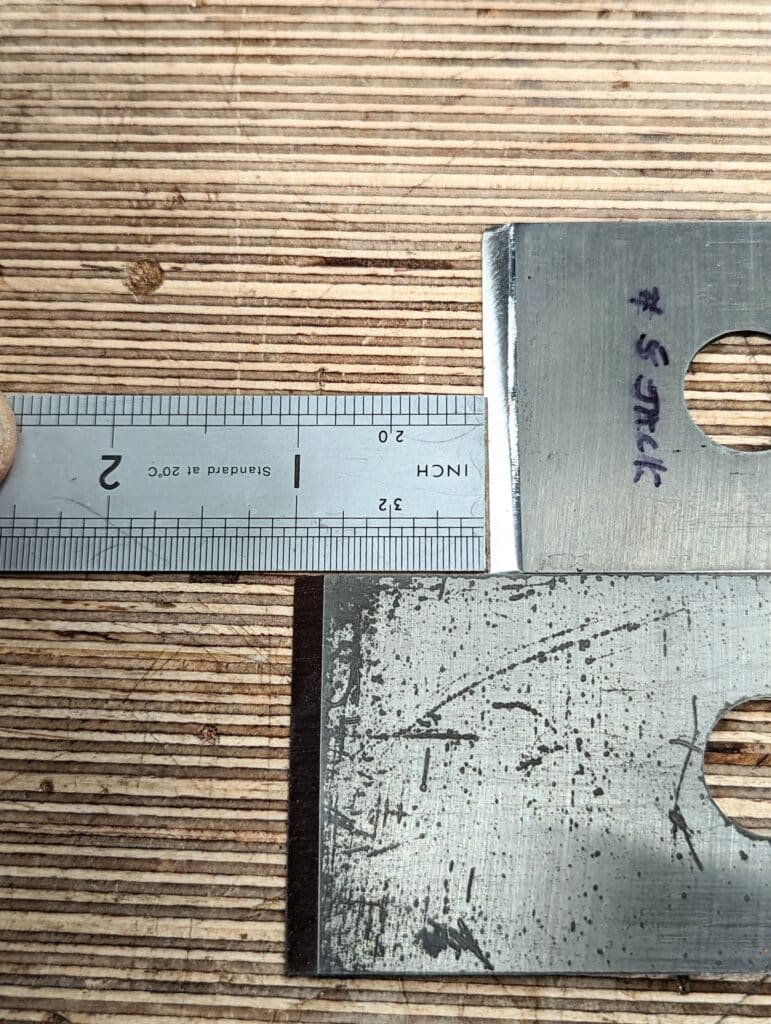
Now to my point. The longer of these two plane irons will replace the shorter one from my #5 Jack plane. It’s just an inch difference but the difference in hardness is where the need for change lies. If I don’t replace or reharden it I will spend more time sharpening it than working with the plane.
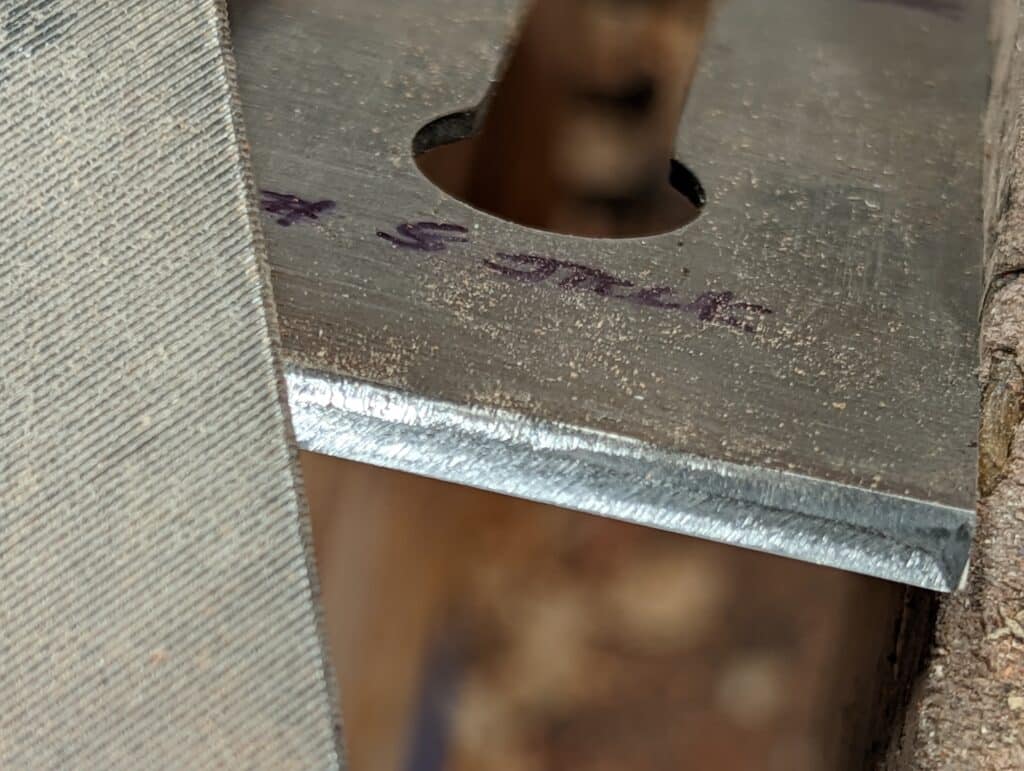
To test further I ran a file on the bevel and it cut the steel almost as easily as if it were mild steel I was filing. That is too soft for a plane iron. Whereas I could just harden the cutting-edge area, there are no guarantees that it might distort the flatness too much to reconcile it. Certainly, in a bind, it would be worth trying. But then again I might just consider putting the steel to better use using the iron for other tool making, small cutting irons and such; the same as I do with old files and such. Waste not want not.

A friend took an odd plane iron and made a blade for a rebate plane he made for me. I thought it was quite ingenious to split the iron in two and use it as he did.
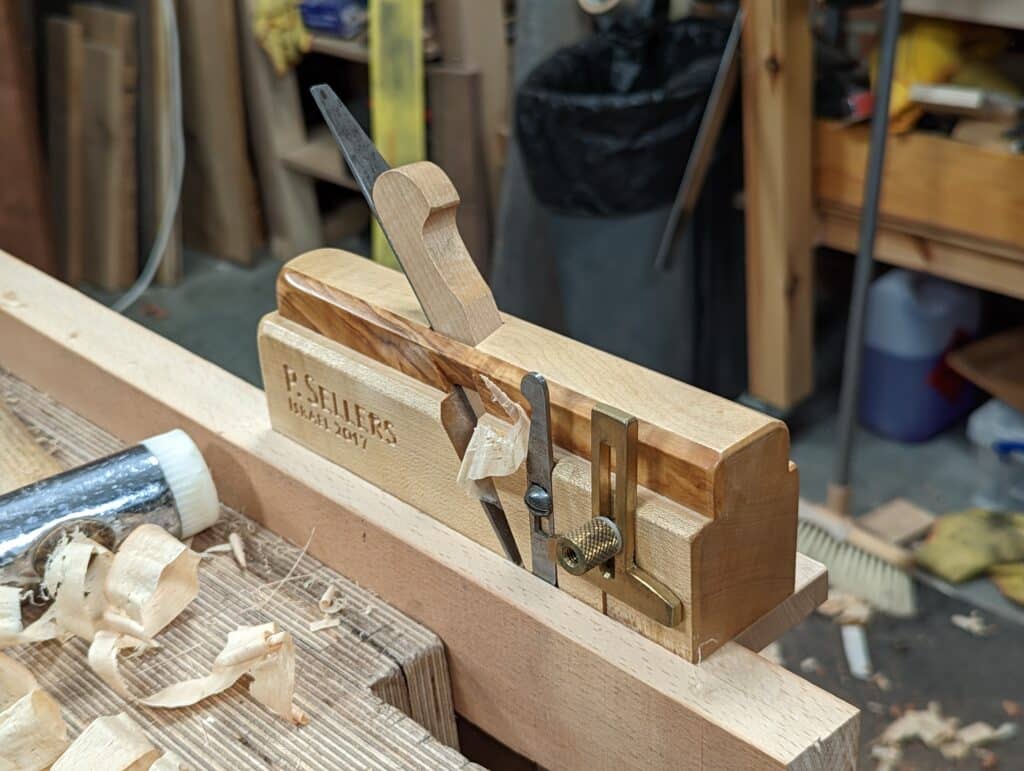
The side cutter for cross-grain cutting was a nice and exact addition too, also made from the same cutting iron.
I will have part two for you tomorrow, all being well and the creek don’t rise. This gives an alternative answer and costs nearly nothing at all.


And here I thought the creeks rising in the UK would’ve been a welcome thing!
Yeah! Panic news across the globe. Two days of sunshine and the Brits cry drought, drought — hose pipe bans everywhere. Doesn’t take too much to freak the Brits out these days, just a talking head or two on the news.
The UK Forest Research has published a few days ago a new guide about:
“Designing and managing forests and woodlands to reduce flood risk.”
Isn’t that good news?
“Woodland creation can make an important contribution to reducing downstream flood risk”.
Hi Paul. It seems as if you use the term Brits in a derogatory fashion nowadays.
Are you not British?
We have enough woke knockers without your tuppence worth!
Ah, are you a Brit? They do get easily needled don’t they? What I said was true though. Remember two months ago we were all going to die of the drought because the presenters on the great British Beeb said so even though we all (99.9%) knew October and November we would get rain every day. Number one moan when we get rain that is much needed is that it’s, well, “so miserable”. Living in another country on another continent does make you see things differently, more considerately. I mean, Brits are very different and do very funny things. Am I a Brit? Of course. We also do great things. So, are you telling me now what I can and can’t say, like Brits are indeed wont to do? This is also a very British thing. For all of its very quirky ways, I do love Britain and its peoples. That’s partly why I am here.
Hi Paul,
You say, “I could just harden the cutting-edge area”
How is this done?
I assume it’s a case of heating until cherry red and then quenching in cold water, or oil…. or is there more to it than that?
Thanks,
Matt
I posted a blog this morning on this, Matt.
Ahh.. That wasn’t out when I posted my question… I don’t think!
Thanks,
Matt
More to it. Need to know where the critical temperature for the specific steel is. You also end up with an oxide layer that needs to be ground back. I’m blacksmith. But…that doesn’t mean don’t try whatever you want on an otherwise less useful iron. you only stand to learn something.
Such a brilliant idea about using a old plane iron like that again with cutting it in two!
So just harden the cutting edge again and voila a new cutting iron is born.
Once at a flea market a few years ago i picked up some old plane irons. I didnt knew back then about the hardened steel bit of the iron that was all grinded off on these. Found that out later while learning more about tools etc.
It’s what i love about reading your blogs, always learning and getting new ideas that makes me amazed with possibilities that hand tool woodworking gives us.
Thanks for all you and your team do.
Friendly regards,
Michel
That’s a beautiful plane your friend made Paul. Love the contrast in the two woods at the top. Very nice indeed.
The hydrogen embrittlement of all steels is also an inevitable factor as they age.
For now, it might be reasonable to assume that pre-1960s irons are still “good”. But there will come a time when due to their thickness regardless of how well they’ve been stored they will become “not so good”.
I’m not into the powder metal alloy stuff just yet. It has promise, but its means of manufacture is beyond my ability to replicate, therefore less interesting.
If you ever need new irons forged there are blacksmiths who *should* be able to do it.
In almost all cutting tools I prefer the temper to be differential, hard in front softer in back.
On losing cutting edges on stuff that likes to eat fine cutting edges; I prefer not to offer the stuff such a fine cutting edge. Australian gummy and silica rich hardwoods being what I’m used to, leaving a rounder, duller edge lasts longer. That don’t mean don’t polish. But strop the bejesus out of it until it’s heaps more cambered on the very tip behind the edge. Such an edge would make a mess of most stuff but rides stuff like red gum (river red gum), red ironbark, grey box, yellow box better. The yellow box has this greasy feeling to it as well, even when it’s cured for years.
Like when people sharpen up a chisel or plane iron and shave the hairs off the back of their arm. As far as I can tell all that proves is the iron is good for shaving hairs off the back of your arm, not even necessarily one’s face (without making a mess).
I feel the same about steel and wood.
Different cuts in different materials need different edges. Subtle perhaps in some cases but the difference is real.
Hello Ben,
Hydrogen embrittlement? On cutting tools at room temperature. Don’t think so. Hydrogen embrittlement occurs in temperatures in excess of 150C when there is an “active” source of hydrogen in proximity. On a tool that is only heated once to be hardened / tempered, I would not think this to be a concern.
It does sometimes make sense to buy a whole plane rather than bits but I’ve encountered 2 problems with that. 1. Can’t always get pics of all parts and 2. I usually end up with plane in hand thinking cannibalise or restore?
I have had to put one old 4 1/2 iron aside because it just wouldn’t keep an edge, any edge. No idea why until now.
Hi Paul, last year I spotted a USA made Stanley SW 4 1/2 on a local market and bought it. It has a laminated blade and is the original with the SW logo. I presume these are hardened all the way up the blade (not that I have actually checked).
P.S. Plywood (edge) is also a very good abrasive in my experience.